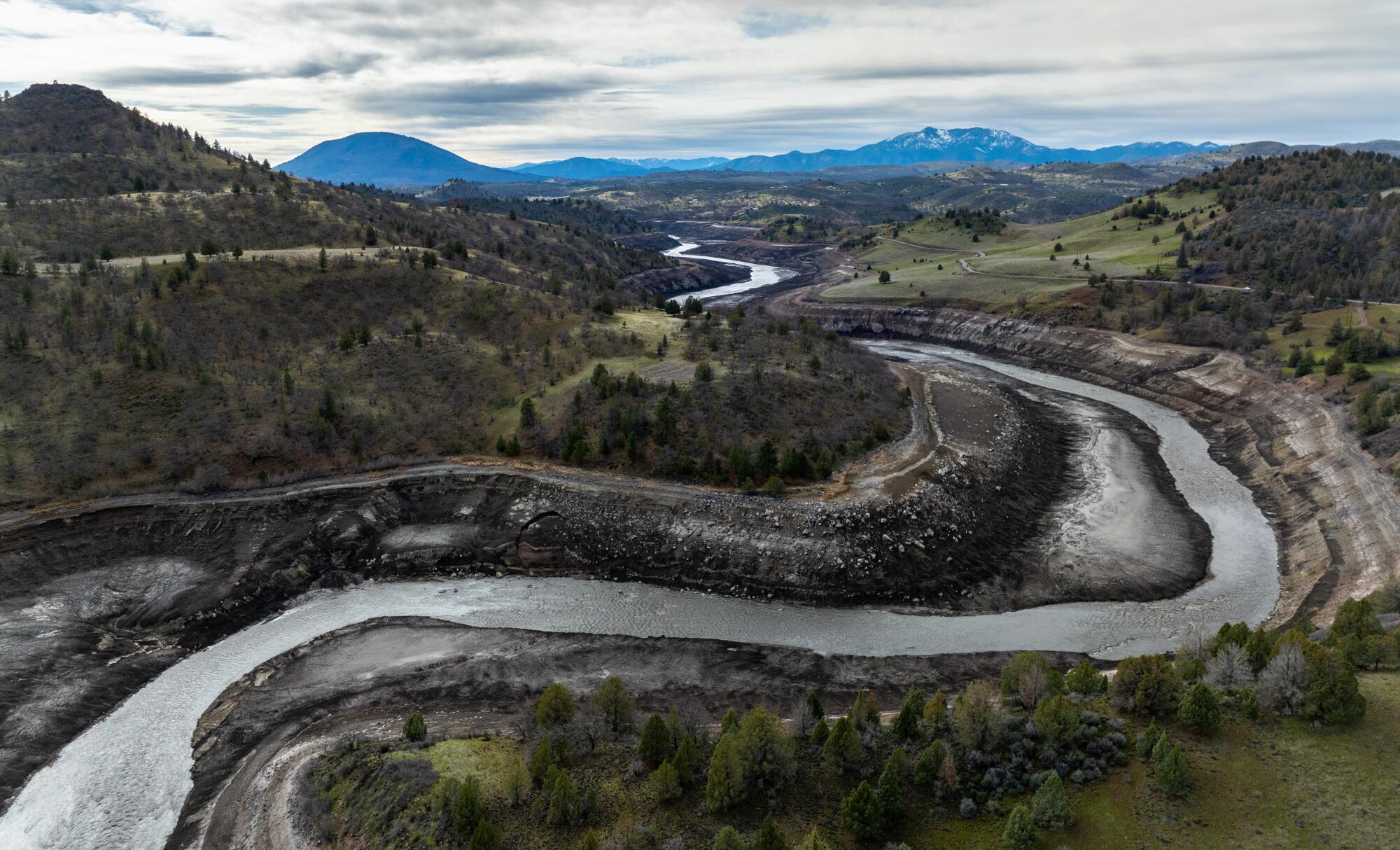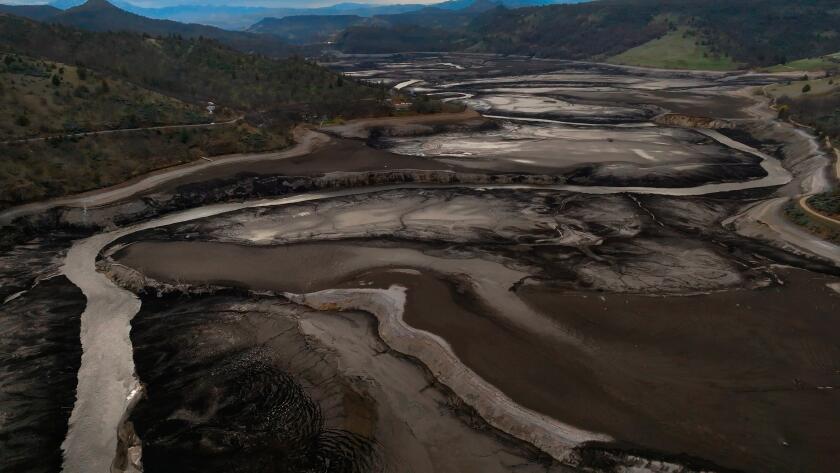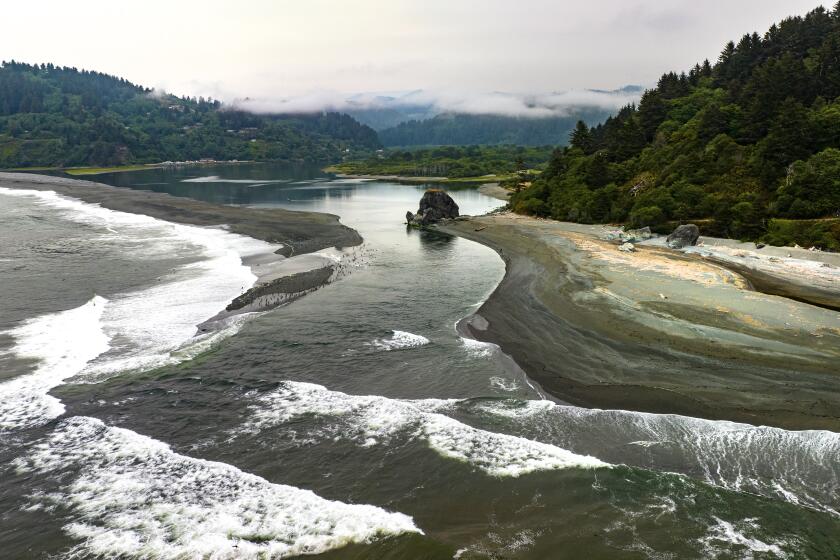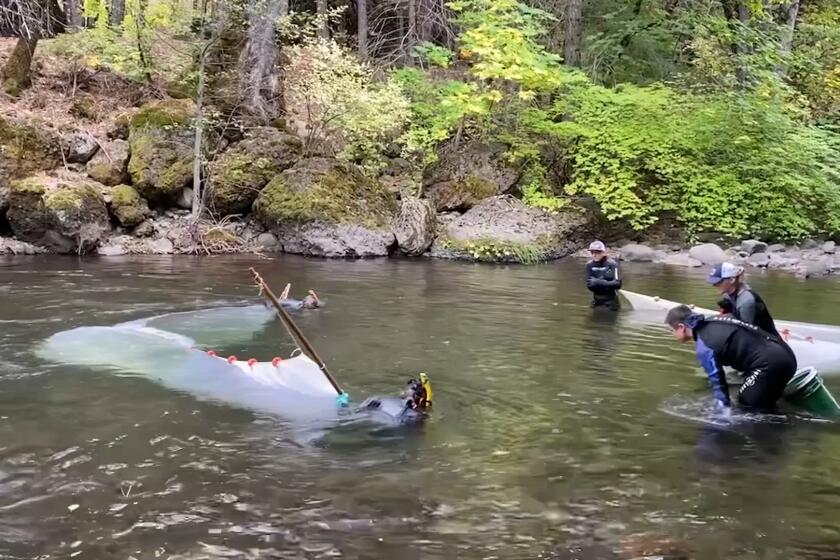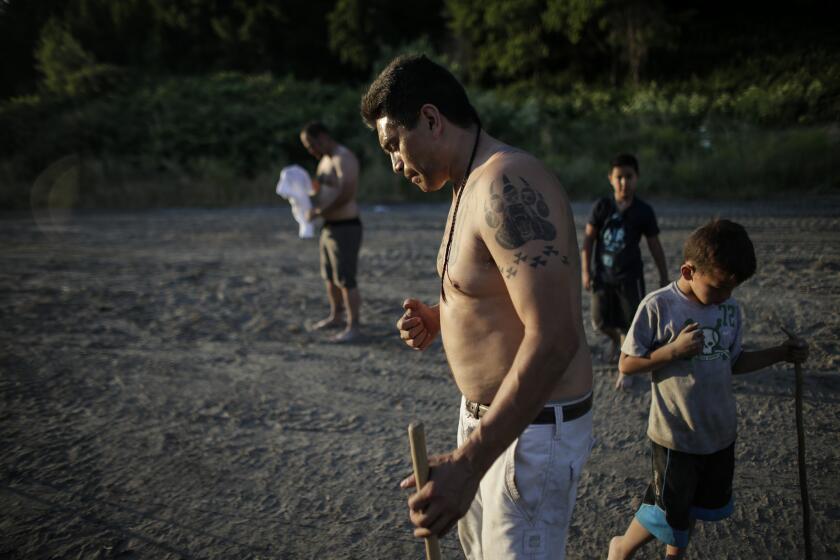Water flows out of Jenny Creek into the Klamath River.
- Share via
HORNBROOK, Calif. — Near the California-Oregon border, reservoirs that once submerged valleys have been drained, revealing a stark landscape that had been underwater for generations.
A thick layer of muddy sediment covers the sloping ground, where workers have been scattering seeds and leaving meandering trails of footprints. In the cracked mud, seeds are sprouting and tiny green shoots are appearing.
With water passing freely through tunnels in three dams, the Klamath River has returned to its ancient channel and is flowing unhindered for the first time in more than a century through miles of waterlogged lands.
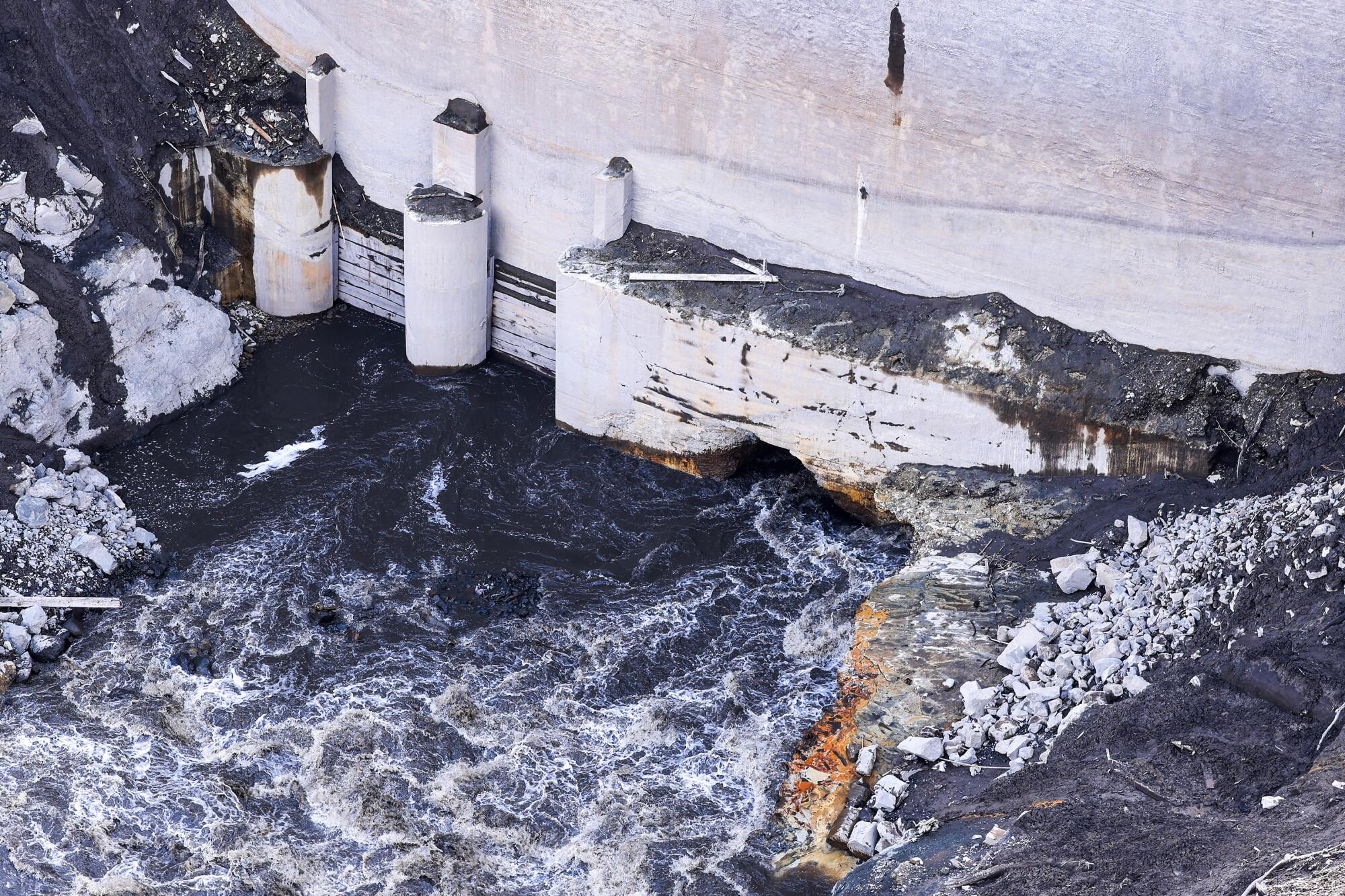
Using explosives and machinery, crews began blasting and tearing into the concrete of one of the three dams earlier this month. While the massive dismantling project advances, a parallel effort to restore the river to a natural state is just beginning.
“It’s a beautiful thing, and a beautiful feeling, that that process of healing has begun,” said Leaf Hillman, a member of the Karuk Tribe who spent more than two decades campaigning for the removal of dams, and who said he’s overjoyed to see the process finally underway.
Standing on a bluff overlooking Iron Gate Dam, Hillman watched the turbid, chocolate-colored water flowing from a tunnel and passing downriver. He said the muddy, sediment-laden water streaming from the drained reservoirs might look ugly to some people, but it’s a sign of improving health that the dead algae and muck that had accumulated in the reservoirs is now being washed out.
“It feels like a cleansing that is long overdue. This river has been literally dying for years, having the life strangled out of it by these dams,” Hillman said. “I love seeing that sediment being pushed down, because that’s a river acting like a river.”
The emptying of the reservoirs, which began in January, is estimated to have released as much as 2.3 million tons of sediment into the river, abruptly worsening its water quality and killing nonnative perch, bluegill and bass that had been introduced in the reservoirs for fishing.
- Share via
Downstream from the dams, the river’s banks are littered with dead fish. But tribal leaders, biologists and environmentalists say that this was part of the plan, and that the river will soon be hospitable for salmon to once again swim upstream to spawn.
For Hillman and other Indigenous activists, the struggle to restore the Klamath involved years of protests — including outside a Scottish Power shareholders meeting in Edinburgh when the U.K. company owned PacifiCorp — until agreements were finally negotiated to remove the hydroelectric dams.
The structures, which were built without tribal consent between 1912 and the 1960s, blocked salmon from reaching vital habitat and degraded the river’s water quality, contributing to toxic algae blooms in the reservoirs and disease outbreaks that killed fish.
Aggressive and impactful reporting on climate change, the environment, health and science.
Hillman is a ceremonial leader and former Karuk vice chairperson. He started his tribe’s fisheries department in 1990, and has seen populations of salmon decline over the years, while algae blooms have fouled the river at times when tribal members traditionally enter the water during ceremonies.
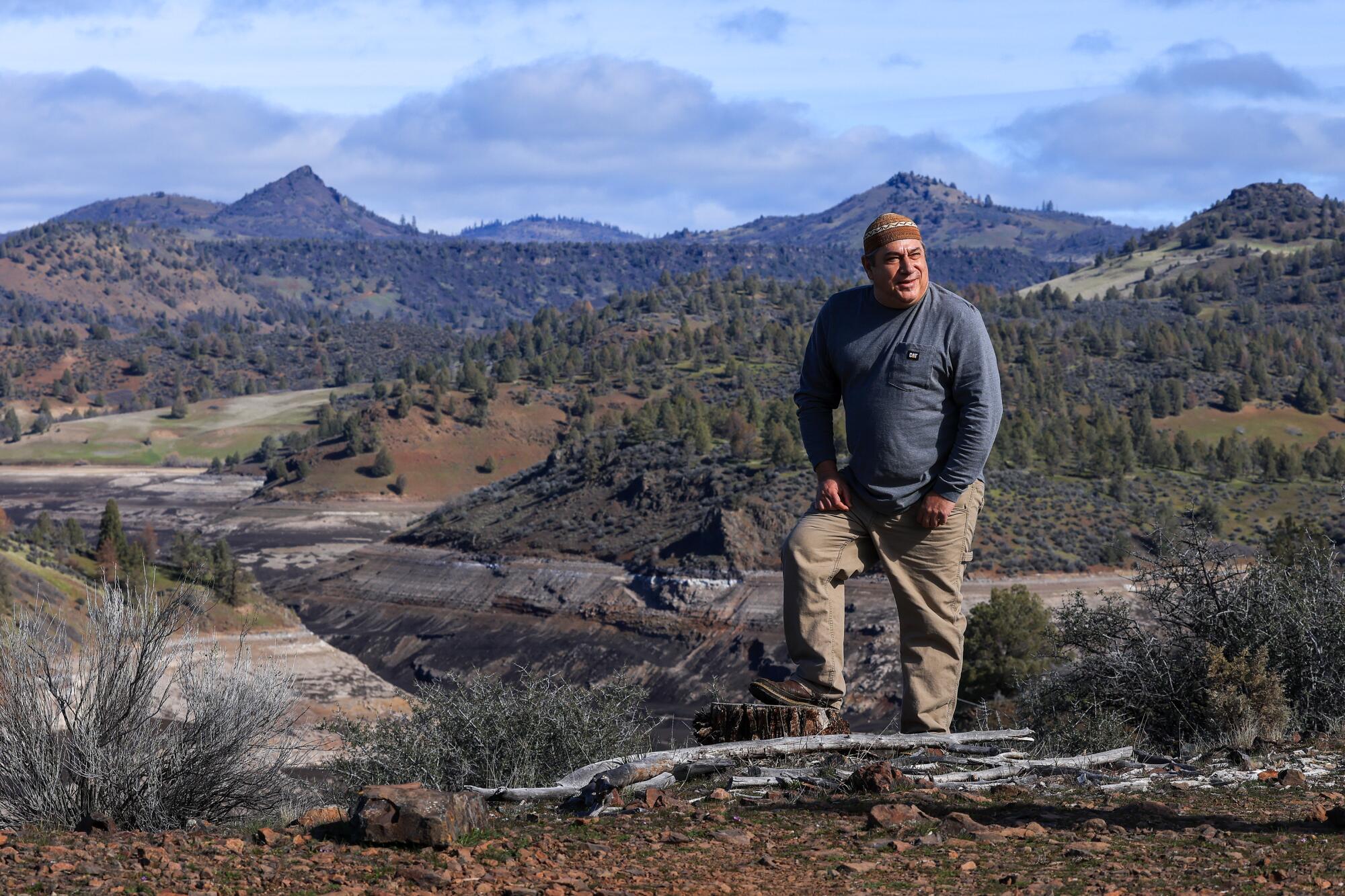
Hillman said that the dams had exacted a terrible cost on Native people’s livelihoods and cultures, and that their removal promises to revive the ecosystem and salmon populations, and help tribes revitalize their fishing traditions and their connection to the river.
Seeing the reservoirs empty and the river returning is like having “a weight off my chest,” Hillman said, “like I feel like I can breathe.”
The largest dam removal project in history, it’s being overseen by the nonprofit Klamath River Renewal Corp., with a $500-million budget including funds from California and from surcharges paid by PacifiCorp customers. The utility, based in Portland, Ore., agreed to remove the aging dams — which were used for power generation, not water storage — after determining it would be less expensive than trying to bring them up to current environmental standards.
Workers have been drilling holes in the top of the Copco No. 1 Dam, placing dynamite and setting off blasts, then using machinery to chip away fractured concrete. The dam, which has been in place since 1918, is scheduled to be fully removed by the end of August. The smaller Copco No. 2 Dam was torn down last year as the project began.
Two earthen dams, the Iron Gate and the John C. Boyle, remain to be dismantled starting in May.
Native activists fought for years to build support for taking down dams on the Klamath River in Northern California. Now, they hope removing the dams will help save their salmon.
If the project goes as planned, the three dams will be gone sometime this fall, reestablishing a free-flowing stretch of river and enabling Chinook and coho salmon to swim upstream and spawn along about 400 miles of the Klamath and its tributaries.
Meanwhile, teams of scientists and workers are focusing on restoring the landscape and natural vegetation on about 2,200 acres of denuded reservoir-bottom lands.
Crews from the Yurok Tribe have been walking in the mud and scattering the seeds of native plants, including grasses, shrubs and trees. This effort started several years ago, with workers collecting nearly 1 billion seeds along the Klamath and sending them to farms to be planted and harvested.
The effort has yielded an estimated 17 billion seeds to date. In some areas, a helicopter has been used to drop seeds along the river.
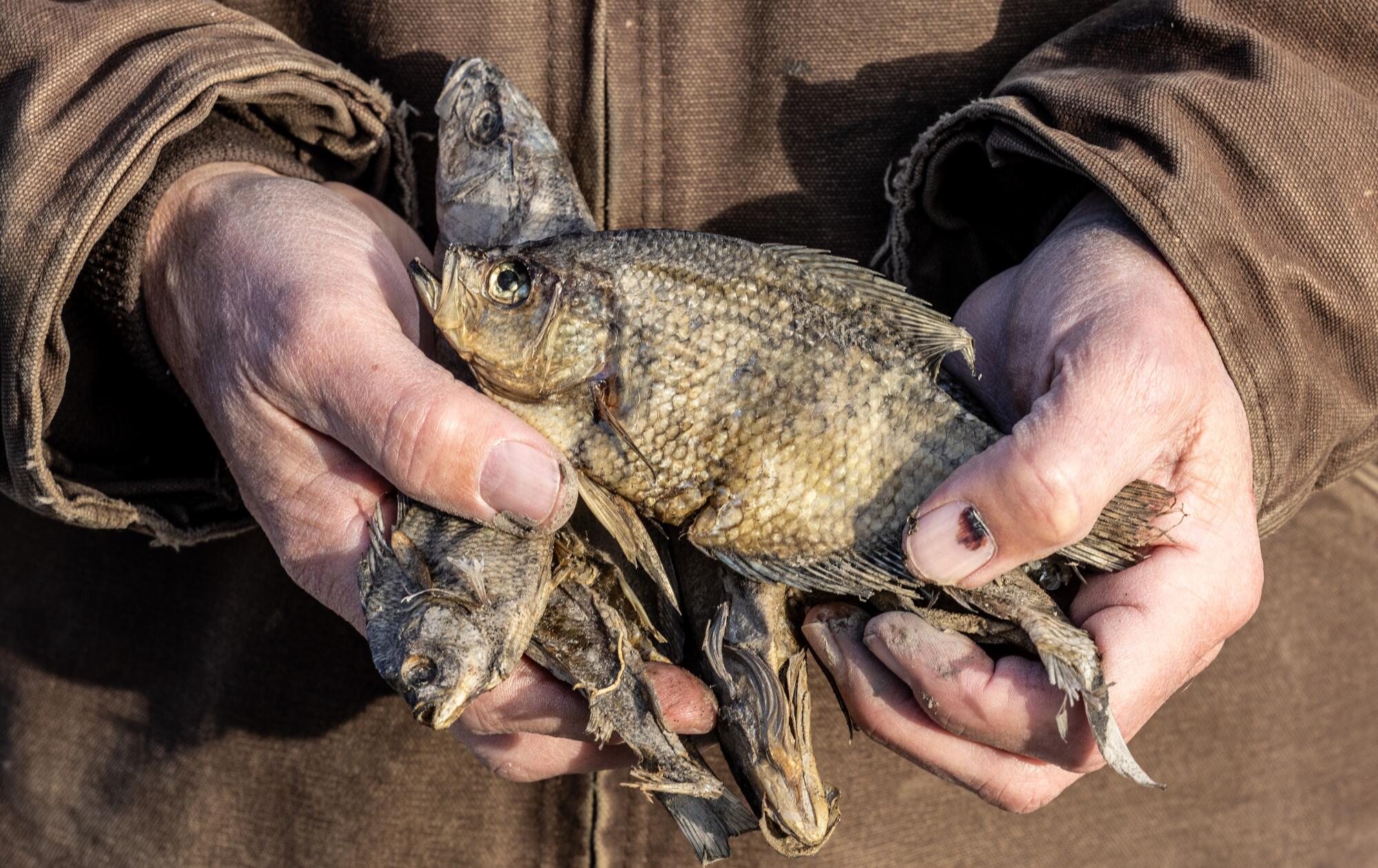
The goals of the seed-planting effort include stabilizing the wet sediment, preventing nonnative weeds from taking hold, and accelerating the regrowth of grasslands, chaparral and forests.
“These reservoirs, they have a lot of invasive species surrounding the landscape,” said Joshua Chenoweth, the Yurok Tribe’s senior riparian ecologist. “And so by introducing a nice, diverse mix of native seed, that’s going to be our strongest protection against it becoming a big weed field.”
That means fewer weeds like medusahead and yellow starthistle, and more native plants like bluebunch wheatgrass and Oregon sunshine. That’s important for the health of the ecosystem.
The approach draws on lessons from the removal of dams on the Elwha River in Washington state, where scattering native seeds was found to effectively reduce the amount of invasive weeds, Chenoweth said.
Within a decade, he and others hope, a stand of young trees will form a lush, green riparian forest along the Klamath.
Alauna Grant, a member of the Karuk Tribe who is helping to plant seeds and saplings, said she is pleased to be participating in undoing the environmental damage caused by the dams, and expects the next generation, including her nieces and nephews, will appreciate a restored river.
“There’s going to be so many swimming spots for them to go hang out at and have fun once the river gets healthy,” Grant said. “I’m excited for it to succeed.”
While the draining of reservoirs let loose heavy loads of sediment, there are also areas where piles of sand, gravel and clay lie up to 15 feet deep beside tributary streams. Crews have been working with excavators, digging into the piles and sending sediment tumbling into streams.
“Dam removal is kind of messy business,” said Dave Coffman, manager of the restoration program for the contractor Resource Environmental Solutions, or RES. He likened the process to “heart surgery, where we got the arteries cleared out, and things are moving again.”
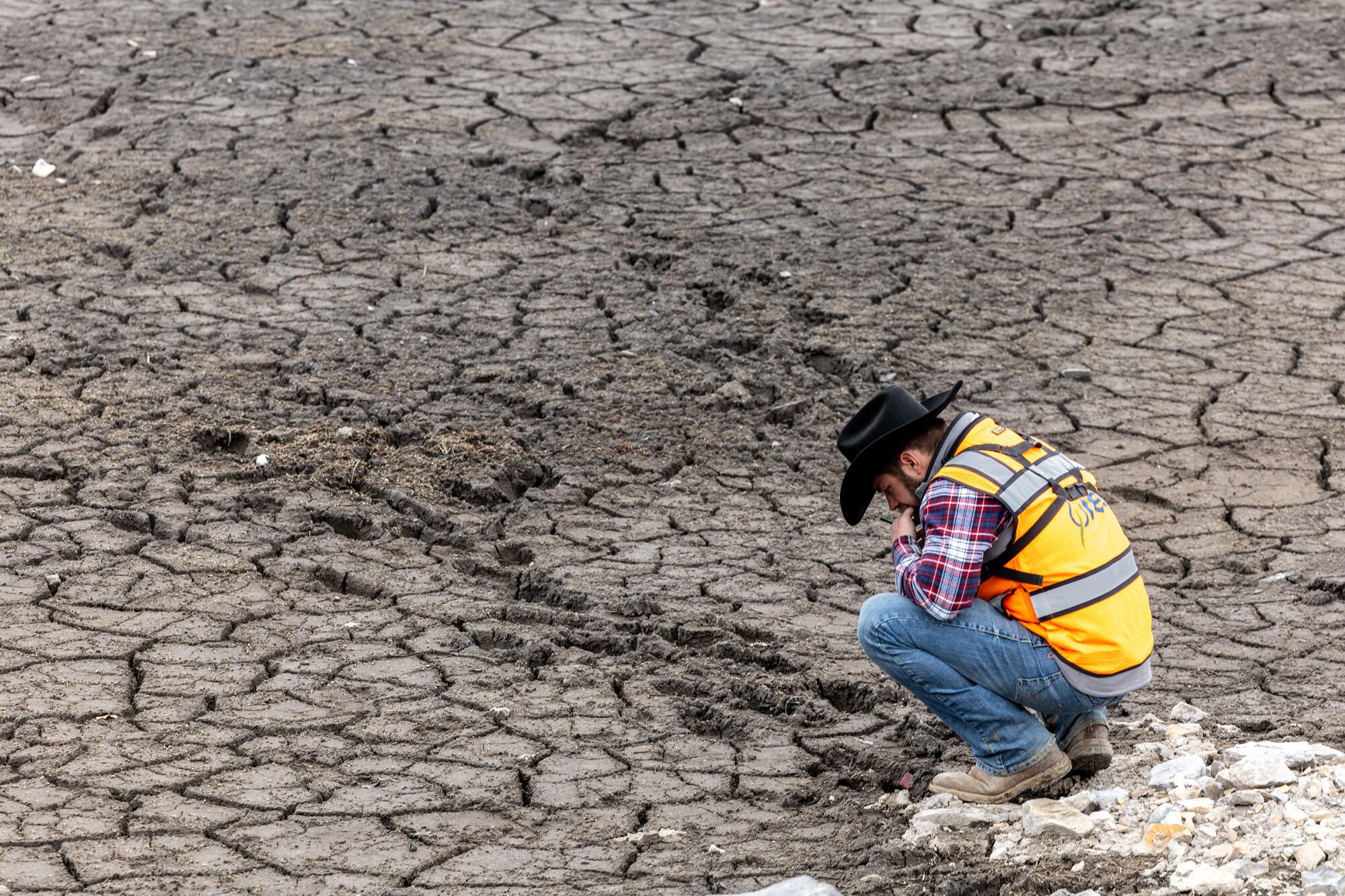
Based on studies, the project’s planners knew that the sediment would temporarily have a severe effect on water quality, causing a drop in the amount of oxygen in the water, Coffman said. To minimize potential harm to native fish, they chose to begin draining the reservoirs in the winter, after adult salmon had spawned and died. It’s also a time when newly hatched juvenile salmon remain in tributary streams to feed and grow.
Before the drawdown began, a crew of Karuk fisheries specialists waded into the river to net and trap as many young coho salmon as they could find, and moved them to holding ponds, where they are being kept until the water quality improves.
Biologists have begun collecting California’s spring-run Chinook salmon to raise them in captivity in an effort to prevent extinction.
Other efforts haven’t worked out as planned. When workers from the California Department of Fish and Wildlife took 830,000 juvenile Chinook salmon from the newly built Fall Creek Fish Hatchery and released them into a tributary on Feb. 26, they found that the fish were dying as they passed through a tunnel beneath Iron Gate Dam. The dead salmon showed signs of gas bubble disease, which can occur when water is supersaturated with dissolved gases.
After that setback, state wildlife officials said they would instead release young salmon downstream of the dam until it’s removed. The hatchery still has millions of fish scheduled to be released later this year, and teams from the Karuk Tribe’s fisheries department have also been finding healthy wild salmon in the river.
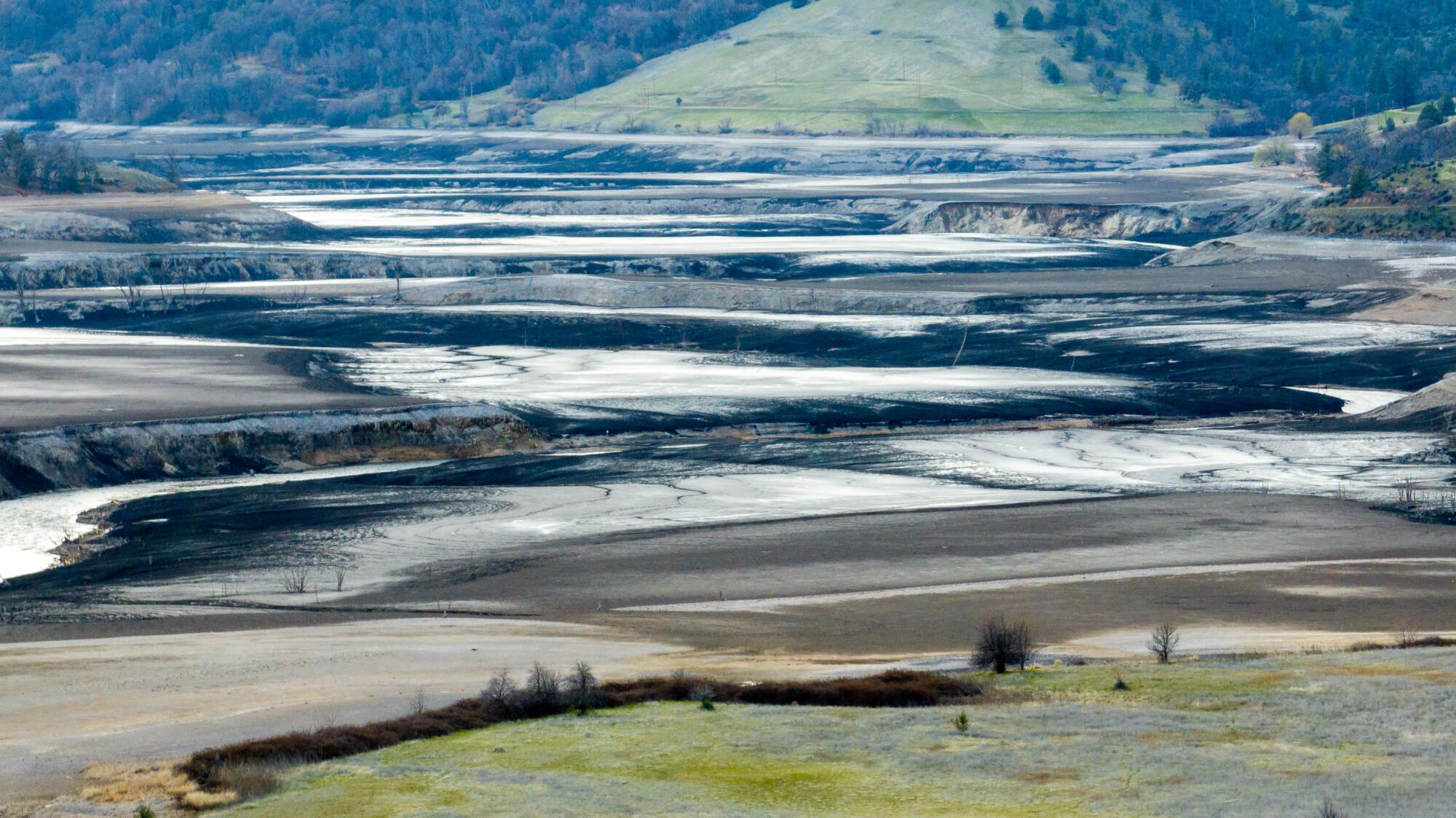
The river’s water quality has been improving, but the restoration work will continue until vegetation is established and the water clarity has improved to normal conditions, Coffman said.
“This landscape will be restored,” he said. “But when it comes to revegetating a landscape of this scale, that’s a process that just takes time.”
Coffman stood by a dry boat ramp in the community of Copco Lake, where homes that used to have lakefront views and docks now face an expanse of mudflats. In the distance, the bare skeletons of trees that were drowned a century ago protruded from the lake bed.
“This still looks like a barren mudflat from this perspective,” Coffman said. Then, he squatted and pointed to sprouting seeds: “Those little green shoots are the first step in that process, that road to recovery.”
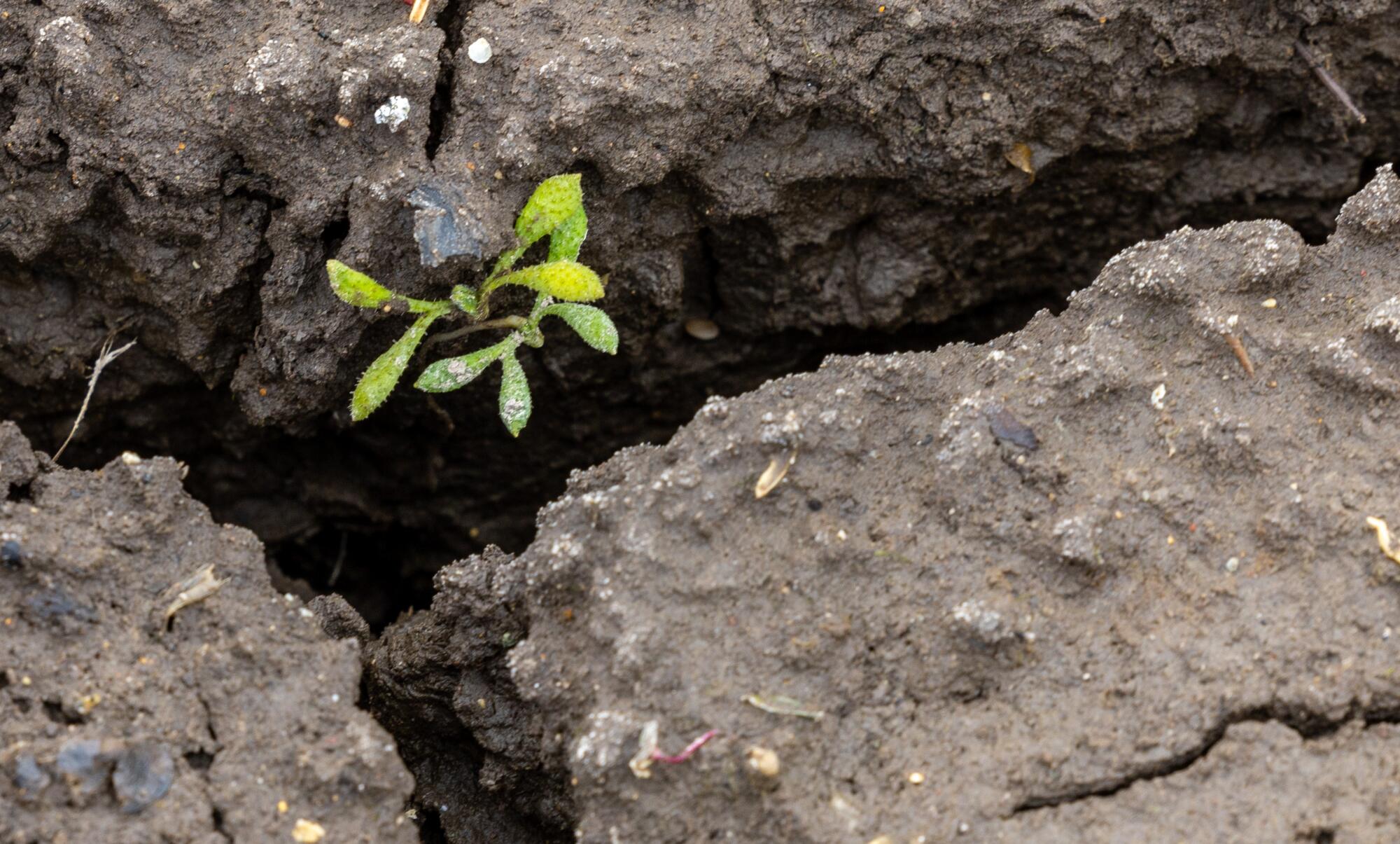
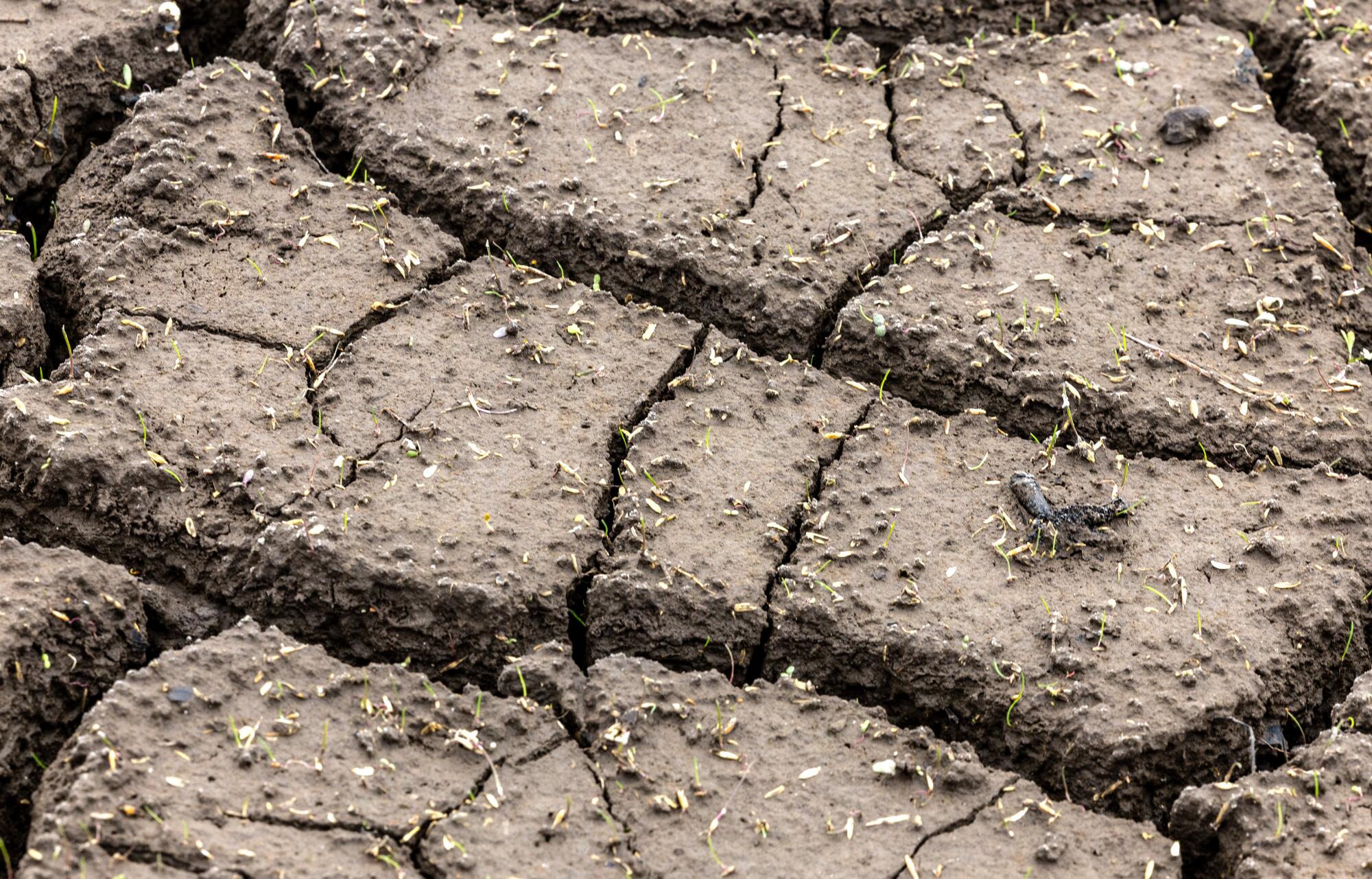
By planting several different types of vegetation in zones extending from the river to the uplands, he said, the crews are putting the watershed on a “positive ecological trajectory” to let nature take its course.
“We get it pointed in the right direction, and the environment does the rest,” Coffman said.
Driving on a road beside the drained reservoir, Coffman stopped at a small waterfall cascading down a hillside in a thick stand of trees. He said that springs like this send water flowing onto flats by the river, creating streams that offer an opportunity to restore a wetland that will attract birds and other wildlife.
“And where that little channel meets the Klamath River is going to be a nice, cool spot for fish to come,” he said. “Where there is water, there is life. And that’s what we’re going to see.”
River restoration advocates are optimistic. They say undamming the Klamath will demonstrate the potential for restoring free-flowing rivers elsewhere in California, and point to initial plans to remove two dams on the Eel River as another promising opportunity.
Ann Willis, California regional director for the environmentalist group American Rivers, said that when she’s rafted on the Klamath previously, the water downstream of the dams has been warm, green and smelly. At times, the algae blooms made it unsafe to get wet.
Willis said she hopes removing dams is “going to not just restore an ecosystem, but really restore access” for people who live along the Klamath to enjoy their river once again. She added that there are many unknowns about how the recovery of the river ecosystem will progress amid the extremes driven by climate change.
“I am still confident that whatever comes out of this is going to be something that benefits the entire community,” Willis said. “Rivers are living systems, and they create these beautiful worlds.”
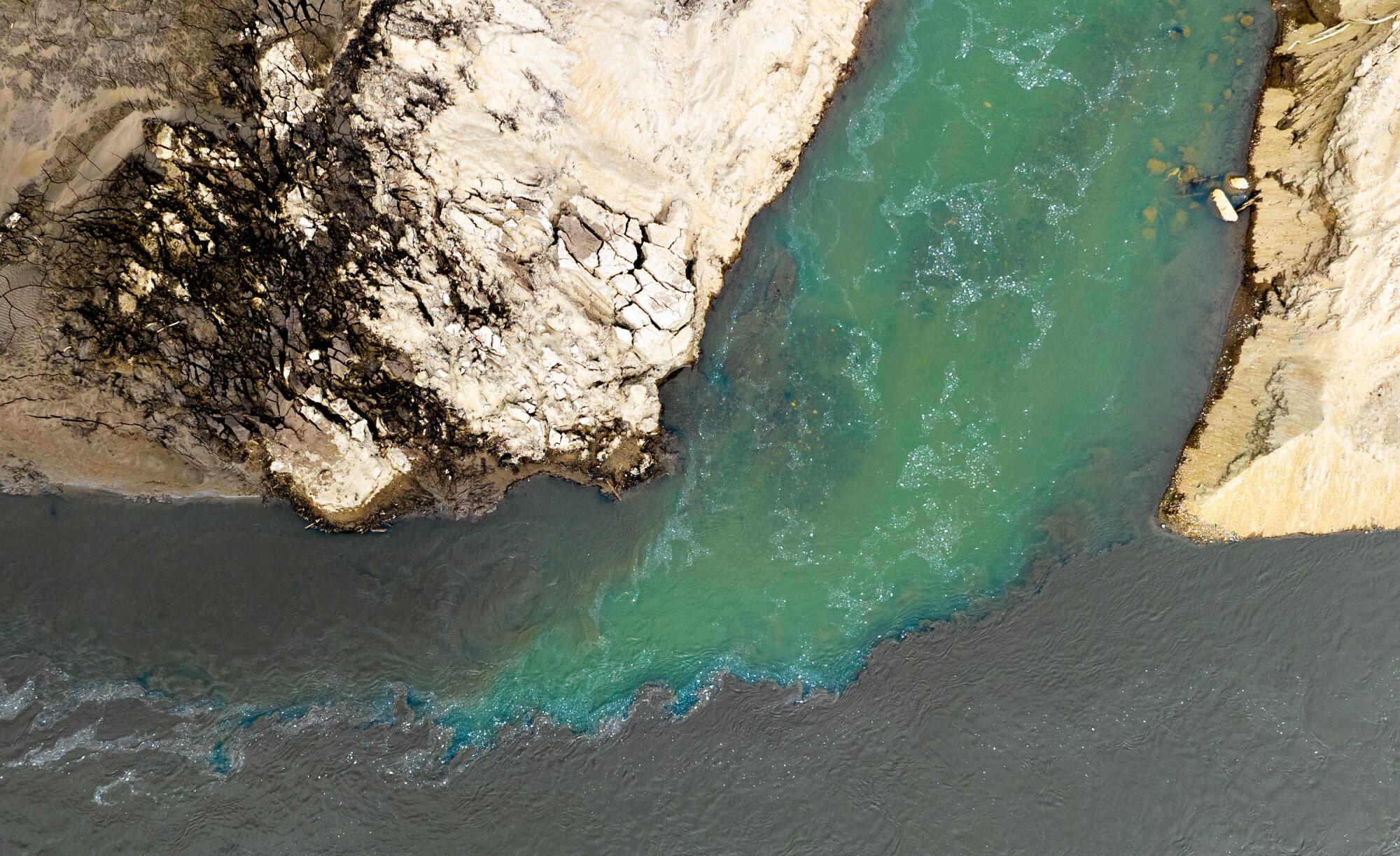
In recent decades, major declines in salmon populations have negatively affected people’s health and wellbeing in communities along the river, including by hindering their fishing traditions, said Regina Chichizola, executive director of the organization Save California Salmon. Now, she said, the undamming of the river is bringing a new outlook for young Native people.
“For the first time, I’m hearing hope — young people feeling like there might be a future with salmon in it for them again,” she said.
When the removal of dams is complete, the Klamath River Renewal Corp. will turn over the land to California and Oregon. The Shasta Indian Nation, whose ancestral homeland lies along the river, has requested that some of these lands be returned to their people.
Hillman, of the Karuk Tribe, said that once the dams are gone, people will be able to return with nets to traditional fishing places that were sealed off long ago.
He walked to a rocky point overlooking the river. Beside him was the brick chimney of a house that burned down decades ago, and below was the concrete dam that had formed Copco Lake. Water was rushing through a tunnel at the base of the dam.
“I’ll be glad to see it gone,” Hillman said. “These dams being here — it was a huge mistake that continues to have impacts.”
Their construction, he said, compounded the struggles of the Klamath’s Native peoples, who also suffered systemic violence during the taking of their lands. On top of these injustices, he said, the surrounding forests are unhealthy and prone to intense fires because they have been deprived of traditional burning during more than a century of fire suppression.
“We have a lot more work to do to fix this place,” Hillman said.
That larger effort to regain the watershed’s natural balance, he said, is just beginning as the dams come down.
“What it represents to me,” he said, “is an opportunity to reclaim what’s been lost.”
